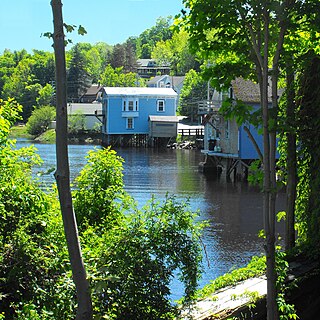
The Annapolis Valley is a valley and region in the Canadian province of Nova Scotia. It is located in the western part of the Nova Scotia peninsula, formed by a trough between two parallel mountain ranges along the shore of the Bay of Fundy. Statistics Canada defines the Annapolis Valley as an economic region, composed of Annapolis County, Kings County, and Hants County.

The Bay of Fundy is a bay between the Canadian provinces of New Brunswick and Nova Scotia, with a small portion touching the U.S. state of Maine. It is an arm of the Gulf of Maine. Its extremely high tidal range is the highest in the world. The name is likely a corruption of the French word fendu, meaning 'split'.

Digby is an incorporated town in southwestern Nova Scotia, Canada. It is in the historical county of Digby and a separate municipality from the Municipality of the District of Digby. The town is situated on the western shore of the Annapolis Basin near the entrance to the Digby Gut, which connects the basin to the Bay of Fundy.

The Annapolis Basin is a sub-basin of the Bay of Fundy, located on the bay's southeastern shores, along the northwestern shore of Nova Scotia and at the western end of the Annapolis Valley.

Highway 101 is an east-west highway in Nova Scotia that runs from Bedford to Yarmouth.

The Annapolis River is a Canadian river located in Nova Scotia's Annapolis Valley.

Nova Scotia is a province located in Eastern Canada fronting the Atlantic Ocean. One of the Maritime Provinces, Nova Scotia's geography is complex, despite its relatively small size in comparison to other Canadian provinces.

Long Island is a Canadian island in Digby County, Nova Scotia.
Digby Neck is a Canadian peninsula extending into the Bay of Fundy in Digby County, Nova Scotia.

The Nova Scotia peninsula is a peninsula on the Atlantic coast of North America.

North Mountain is a narrow southwest-northeast trending volcanic ridge on the mainland portion of southwestern Nova Scotia, stretching from Brier Island to Cape Split. It forms the northern edge of the Annapolis Valley along the shore of the Bay of Fundy. Together with South Mountain, the two ranges form the Annapolis Highlands region.

SS Princess Helene was a passenger and cargo ferry operated by the Canadian Pacific Railway (CPR).

The Fundy Basin is a sediment-filled rift basin on the Atlantic coast of southeastern Canada. It contains three sub-basins; the Fundy sub-basin, the Minas Basin and the Chignecto Basin. These arms meet at the Bay of Fundy, which is contained within the rift valley. From the Bay of Fundy, the Minas Basin trends northeast to Nova Scotia. Chignecto Bay runs from the Bay of Fundy northwest between New Brunswick and Nova Scotia which is separated from the waters of the Northumberland Strait by the Isthmus of Chignecto. The Fundy Basin is best known for the bay it contains. The Bay of Fundy is home to huge tidal changes and tidal bores. It is part of the system of Eastern North America Rift Basins.
Smith's Cove is a community in the Canadian province of Nova Scotia, located in the Municipality of the District of Digby. in Digby County. It is one of several villages in the Annapolis Valley district of Nova Scotia.
Victoria Beach is a small community in the Canadian province of Nova Scotia, in Annapolis County. It is on the shore of Digby Gut, a narrow channel connecting the Bay of Fundy with the Annapolis Basin.
Round Hill is an historic community on the Annapolis River in Nova Scotia’s verdant Annapolis Valley halfway between the Valley market towns of Bridgetown and Annapolis Royal. It is 10 kilometres east of Annapolis Royal on Route 201 and the same distance west of Bridgetown.

The Bear River is a minor river in western Nova Scotia, Canada. Flowing from south to north, it is 40 kilometres (25 mi) long from its headwaters to its discharge into the Annapolis Basin, some 6 kilometres (3.7 mi) east of Digby. The river is tidal for the last 9.7 kilometres (6.0 mi) of its length. The village of Bear River is situated near the head of the tide where shipbuilding took place in the nineteenth century.

The current Point Prim Lighthouse is the fourth in a line of lighthouses built at Point Prim in Canada since 1804. It is located at the mouth of the Digby Gut, which connects the Bay of Fundy with the Annapolis Basin. It is located approximately 8.5 km outside Digby.

The following outline is provided as an overview of and topical guide to Nova Scotia:















